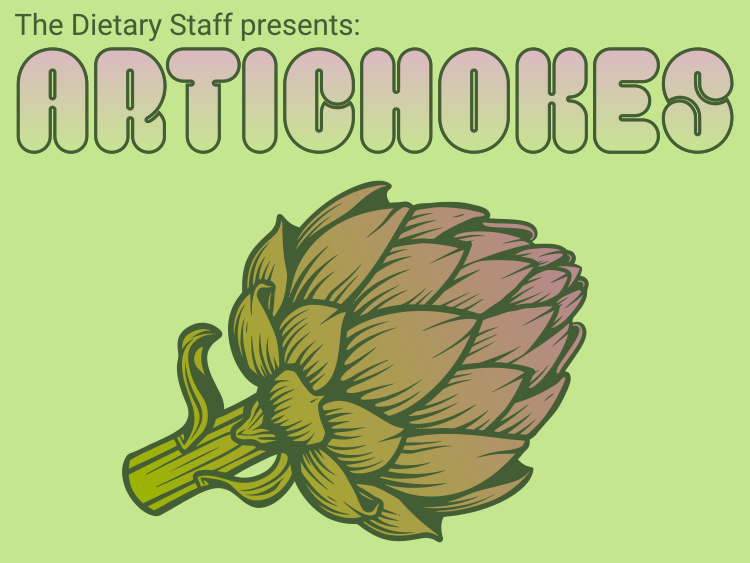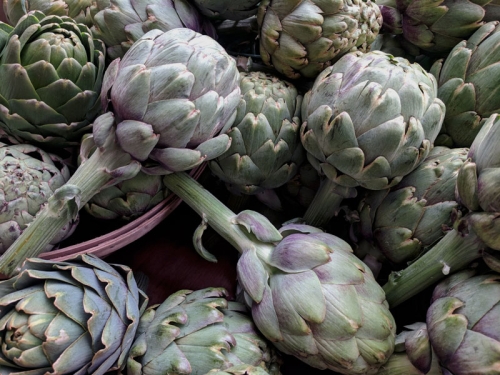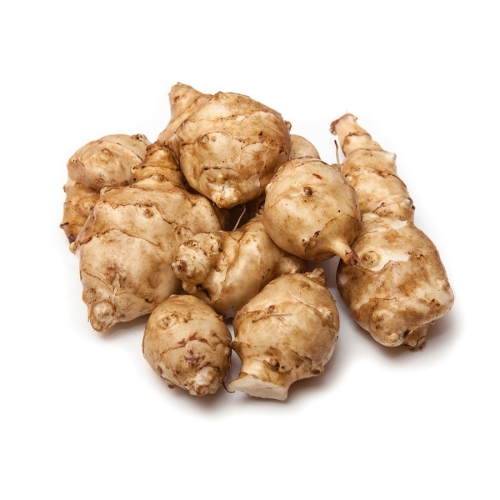
Health Benefits of Artichokes
Artichokes are green vegetables native to the Mediterranean region and are often a key feature in Mediterranean cuisine. They may seem intimidating to prepare but require simple steaming and offer many health benefits. They are particularly high in protein and fiber.

Note Jerusalem artichokes, also known as Sunchokes, are not true artichokes. They are elongated tubers that look similar to ginger root. They are often used as an alternative to potatoes.

WHAT MAKES ARTICHOKES GREAT?
Nutrition
1 medium steamed artichoke provides 60 calories, 4 gm protein, 7 gm fiber, no fat and no cholesterol.
Vitamins
Like other green vegetables, they are rich in vitamin C which is an age-fighting antioxidants, boosts immune function and helps to produce collagen. Folate helps with cell division and DNA production, prevents neural tube defects in a growing fetus. Vitamin K is important for healthy blood clotting and bone formation. Also provide polyphenol antioxidants and flavonoids.
Minerals
Artichokes are a good source of potassium that supports heart function, aids in muscle contraction and regulates blood pressure. Magnesium also helps in muscle contraction and blood sugar regulation. Manganese helps with collagen production and supports bone health.
Fiber
A high-fiber vegetable, artichokes are rich in inulin, a type of soluble fiber that feeds our good gut bacteria. They, in turn, make short chain fatty acids that help to prevent disease. Soluble fiber also lowers cholesterol, triglycerides and blood sugars.
BUYING & USING ARTICHOKES
When buying artichokes, look for ones with a heavy feel and firm, tightly packed leaves. A fresh artichoke leaf will squeak when rubbed. Usually available May through September in most grocers.
Artichokes are usually steamed before eating. Begin by cutting off the sharp leaf tips with knife or scissors to prevent being pricked. Place head in a pan with an inch or two of water and bring to a low boil. Cover the pan half way, allowing steam to escape. Steam 30-50 minutes or until stem pierces easily with a fork. Heads can also be microwaved 8-10 minutes. Artichoke is done when the leaf comes away from the stem with little resistance. Drain by tipping them upside down.
Remove the leaves and notice the soft edible section at the base of the leaf. Bite and scrape this section to remove the edible vegetable. Discard the remaining leaf. Continue to eat leaves until you reach a fibrous layer. This is inedible. Scrape with a spoon to expose the heart, or soft interior. This is often used in main dishes or salads.
Often, high fat dips accompany the artichoke leaves, including butter, mayonnaise or ranch dressing. Instead, try dipping in hummus, honey mustard, Greek yogurt, Aioli sauce or pesto.
Jars or cans of artichoke hearts usually have added oils and salt. Canned hearts are easy to use but add calories and excess sodium. The vitamin C in canned artichokes is greatly reduced in the canning process. Choose canned artichoke hearts that are low in sodium or sodium free and packed in water. Salted artichoke hearts can be rinsed before using. Frozen artichoke hearts are usually lower in sodium than canned.
Chop fresh, canned or frozen (thawed) artichoke hearts into salads, soups or stews or as a pizza topping. Mash and spread on toast or swirl them into risotto sauce or marinera. Add to hummus or spinach dip and serve with cut vegetables or artisan bread.
Artichoke Hummus
feedmephoebe.com
Ingredients:
- 1 (14-oz) can chickpeas
- 1 (14-oz) can artichoke hearts
- ½ cup tahini
- 2 Tbsp lemon juice
- 2 cloves garlic
- ¼ cup water
- 1 tsp salt
- ½ tsp cumin
- ¼ tsp red pepper flakes
- 1 Tbsp parsley, chopped
Directions:
- Combine all ingredients except parsley in a food process and puree until smooth. Taste for seasoning.
- Transfer to serving bowl and garnish with fresh parsley.
- Serve with crackers, fresh artisan bread or cut vegetables.
Artichoke Pesto
veganwithgusto.com
Ingredients:
- 1½ cups artichoke hearts
- ½ cup parsley or basil
- 3 cloves garlic or 1 tsp powder
- 3 Tbsp lemon juice
- 2 Tbsp unsalted sunflower seeds or pine nuts
- Salt and pepper to taste
- Option: Add 1 Tbsp nutritional yeast for a cheesy flavor
Directions:
- Quarter the artichoke hearts and press between 2 paper towels to release excess water.
- Add sunflower seeds to food processor and pulse a few times. Then add remaining ingredients and blend. Make as smooth or creamy as desired.
- Taste and adjust the lemon juice, salt and pepper. vegetables.
- Serve with pasta or cooked vegetables, mix into dips or hummus, or use as a pizza sauce.
Artichoke Arugula Salad
tasteofhome.com
Ingredients:
- 8 cups fresh arugula or baby spinach
- 1 can (14 oz) artichoke hearts, rinsed, drained, chopped
- 1 cup dried cranberries
- ¾ cup pecans, toasted, chopped
- 4 green onions
- ½ cup reduced-fat raspberry vinaigrett
- 3/4 cup crumbled feta cheese
Directions:
Combine ingredients. Drizzle with dressing and sprinkle with cheese if desired.
Spinach and Artichoke Dip
Forksoverknives.com
Ingredients:
- 1¼ cups unsweetened plant milk (soy, almond)
- 3 Tbsp all-purpose flour
- 1 tsp onion powder
- 1 tsp garlic powder
- 1 Tbsp lemon juice
- 2 cups finely chopped spinach, fresh or frozen and thawed
- 1 (14-oz) can artichoke hearts drained and chopped flavor
- Salt and pepper to taste
- Options: scallions, green onions, fresh garlic, Dijon mustard, sriracha, nutritional yeast or balsamic vinegar
Directions:
- Quarter the artichoke hearts and press between 2 paper towels to release excess water.
- Add sunflower seeds to food processor and pulse a few times. Then add remaining ingredients and blend. Make as smooth or creamy as desired.
- Taste and adjust the lemon juice, salt and pepper. vegetables.
- Serve with pasta or cooked vegetables, mix into dips or hummus, or use as a pizza sauce.
References

Oregon State University Extension Service prohibits discrimination in all its programs, services, activities and materials.